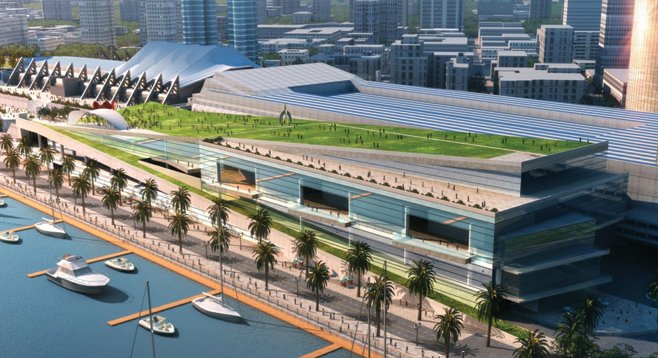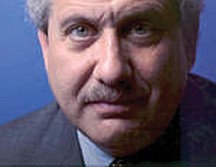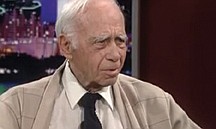 Facebook
Facebook
 X
X
 Instagram
Instagram
 TikTok
TikTok
 Youtube
Youtube

Can common sense and the legal system keep a bubble from inflating further? And maybe prevent a traumatic bursting? San Diego could be the canary in the coal mine on these critical questions.
The subject is convention centers. All around the country, new centers are being built and old ones expanded and refurbished, even though convention attendance has been dropping for years and centers are slashing prices and losing money. It’s a classic bubble, but San Diego’s power players want to build a half-billion-dollar expansion on the existing center.
To do so, the City has concocted a convoluted trick play to evade the laws. City voters have twice turned down an increase in the hotel tax (called the transient occupancy tax). Under the Constitution, state laws, and the city’s own charter, voters must approve a tax increase. So, fearing a rebuke at the ballot box, the City seeks to unilaterally amend the laws by, in effect, calling the hotel tax an assessment. The city’s hoteliers have supplanted the voters and approved the expansion and taxes to pay for it. A lawsuit challenging that legal legerdemain goes to superior court late this month. In March, the Coastal Commission is tentatively slated to look at the proposed project.

Heywood Sanders, professor of public administration at the University of Texas at San Antonio and the nation’s reigning expert on convention centers, notes that between 2000 and 2011, convention center exhibit hall space ballooned by 35 percent while attendance fell 1.7 percent. Last year, space didn’t increase that much, but “Cleveland and Nashville have new centers opening this year,” he says. San Francisco is expanding the Moscone Center, Los Angeles is planning new space tied to a possible football stadium, and Seattle is planning an expansion.
And all three are cutting rents, as is San Diego. In its 2012 annual report, the San Diego Convention Center Corporation admits that its market “is increasingly being targeted by other western regional convention destinations attempting to lure conventions away by offering free or heavily discounted space and substantially lower hotel rates.” So, San Diego is providing a rent subsidy, too — at the same time it wants to expand into a nationwide glut.
“Almost everybody is discounting and offering free rent,” says Sanders. “Much of the rental incentive hits the bottom line on a center’s operating loss.” The center in Reno, Nevada, is luring conventions with a huge bowling alley for convention-goers, called “the Taj Mahal of bowling.” Las Vegas has its own — er, uh — conventioneer enticements, along with 4 million square feet of convention space, double the second highest, Orlando. The San Diego center admits that the seduction of Sin City “impacts our ability to compete.”
Despite these realities, the bubble keeps expanding. Heywood Sanders, who says the glut will get worse, puts much of the blame on consulting firms that tell every city that a new or expanded center will boost the local economy. “It’s easy enough to build the sucker,” says Sanders. “The question is whether you can get any appreciable increase in business. When the best cases I can find are Las Vegas and Orlando doubling the size of their centers and getting a 10 percent to 15 percent increase in attendance, I don’t think there will be much boost at all for San Diego.” Apparently, says Sanders, “San Diego is building into a perfect storm.”
But local center plans go forward. The villain is a political juggernaut: the establishment corporate welfare machine aligned with organized labor. What politician, Republican or Democrat, can resist such pressure?


Initially, organized labor joined activist Mel Shapiro and lawyer Cory Briggs in the lawsuit that shows how the City’s maneuver is blatantly illegal. (Technically, the opponents are defendants because the City last year filed a validation lawsuit to permit a judge to rule on the matter.) Even City Attorney Jan Goldsmith has reservations about the City’s case. Chuckles Shapiro, “[The City] said, ‘Do you want to settle?’ and we said, ‘The settlement is to go to the ballot.’”

In November, organized labor backed out of the case. In return, the contractor for the proposed expansion granted unions a so-called project labor agreement, guaranteeing workers local hiring and union-level wages and benefits. In a word, the deal stinks. So does politics. Mayor Bob Filner, who had campaigned for a public vote on the convention center, now says he will back it if the court and Coastal Commission give it the nod.
Convention centers are “holes in the ground that governments throw money into,” says Briggs. He points out several additional problems: “The City should have done the [environmental] analysis, not the Port. It’s the City’s project,” he says. Any environmental analysis should be done before there is an approval. But, “The City approved this taxpayer scam before the [environmental] document was finished. The mayor [former mayor Jerry Sanders] and council were gung ho, singing its praises before the document was released.”
The Coastal Commission will consider a number of things. The possibility of a rising sea level resulting from climate change should come up. The project further shuts off views of the bay. And, “You don’t need to expand a convention center on the water. It is not water-dependent,” says Briggs. The City claims it will put a park on the roof of the center. Briggs has one word for that: “bullshit.”
That word applies to the propaganda coming from expansion backers. They cite figures showing how the center propels the San Diego economy — for example, purportedly adding $21 billion to regional coffers since it opened more than 20 years ago. But in a Reader article in December of 2011, Heywood Sanders showed how the convention center falsely inflates those numbers. Last year, city auditor Eduardo Luna confirmed it. But in the discussion about the convention center, the book-cooking barely came up, according to sources who followed the discussions.
Briggs sums it up: San Diego politicians “don’t give a damn about false numbers. False numbers, schmaltz numbers.”


Can common sense and the legal system keep a bubble from inflating further? And maybe prevent a traumatic bursting? San Diego could be the canary in the coal mine on these critical questions.
The subject is convention centers. All around the country, new centers are being built and old ones expanded and refurbished, even though convention attendance has been dropping for years and centers are slashing prices and losing money. It’s a classic bubble, but San Diego’s power players want to build a half-billion-dollar expansion on the existing center.
To do so, the City has concocted a convoluted trick play to evade the laws. City voters have twice turned down an increase in the hotel tax (called the transient occupancy tax). Under the Constitution, state laws, and the city’s own charter, voters must approve a tax increase. So, fearing a rebuke at the ballot box, the City seeks to unilaterally amend the laws by, in effect, calling the hotel tax an assessment. The city’s hoteliers have supplanted the voters and approved the expansion and taxes to pay for it. A lawsuit challenging that legal legerdemain goes to superior court late this month. In March, the Coastal Commission is tentatively slated to look at the proposed project.

Heywood Sanders, professor of public administration at the University of Texas at San Antonio and the nation’s reigning expert on convention centers, notes that between 2000 and 2011, convention center exhibit hall space ballooned by 35 percent while attendance fell 1.7 percent. Last year, space didn’t increase that much, but “Cleveland and Nashville have new centers opening this year,” he says. San Francisco is expanding the Moscone Center, Los Angeles is planning new space tied to a possible football stadium, and Seattle is planning an expansion.
And all three are cutting rents, as is San Diego. In its 2012 annual report, the San Diego Convention Center Corporation admits that its market “is increasingly being targeted by other western regional convention destinations attempting to lure conventions away by offering free or heavily discounted space and substantially lower hotel rates.” So, San Diego is providing a rent subsidy, too — at the same time it wants to expand into a nationwide glut.
“Almost everybody is discounting and offering free rent,” says Sanders. “Much of the rental incentive hits the bottom line on a center’s operating loss.” The center in Reno, Nevada, is luring conventions with a huge bowling alley for convention-goers, called “the Taj Mahal of bowling.” Las Vegas has its own — er, uh — conventioneer enticements, along with 4 million square feet of convention space, double the second highest, Orlando. The San Diego center admits that the seduction of Sin City “impacts our ability to compete.”
Despite these realities, the bubble keeps expanding. Heywood Sanders, who says the glut will get worse, puts much of the blame on consulting firms that tell every city that a new or expanded center will boost the local economy. “It’s easy enough to build the sucker,” says Sanders. “The question is whether you can get any appreciable increase in business. When the best cases I can find are Las Vegas and Orlando doubling the size of their centers and getting a 10 percent to 15 percent increase in attendance, I don’t think there will be much boost at all for San Diego.” Apparently, says Sanders, “San Diego is building into a perfect storm.”
But local center plans go forward. The villain is a political juggernaut: the establishment corporate welfare machine aligned with organized labor. What politician, Republican or Democrat, can resist such pressure?


Initially, organized labor joined activist Mel Shapiro and lawyer Cory Briggs in the lawsuit that shows how the City’s maneuver is blatantly illegal. (Technically, the opponents are defendants because the City last year filed a validation lawsuit to permit a judge to rule on the matter.) Even City Attorney Jan Goldsmith has reservations about the City’s case. Chuckles Shapiro, “[The City] said, ‘Do you want to settle?’ and we said, ‘The settlement is to go to the ballot.’”

In November, organized labor backed out of the case. In return, the contractor for the proposed expansion granted unions a so-called project labor agreement, guaranteeing workers local hiring and union-level wages and benefits. In a word, the deal stinks. So does politics. Mayor Bob Filner, who had campaigned for a public vote on the convention center, now says he will back it if the court and Coastal Commission give it the nod.
Convention centers are “holes in the ground that governments throw money into,” says Briggs. He points out several additional problems: “The City should have done the [environmental] analysis, not the Port. It’s the City’s project,” he says. Any environmental analysis should be done before there is an approval. But, “The City approved this taxpayer scam before the [environmental] document was finished. The mayor [former mayor Jerry Sanders] and council were gung ho, singing its praises before the document was released.”
The Coastal Commission will consider a number of things. The possibility of a rising sea level resulting from climate change should come up. The project further shuts off views of the bay. And, “You don’t need to expand a convention center on the water. It is not water-dependent,” says Briggs. The City claims it will put a park on the roof of the center. Briggs has one word for that: “bullshit.”
That word applies to the propaganda coming from expansion backers. They cite figures showing how the center propels the San Diego economy — for example, purportedly adding $21 billion to regional coffers since it opened more than 20 years ago. But in a Reader article in December of 2011, Heywood Sanders showed how the convention center falsely inflates those numbers. Last year, city auditor Eduardo Luna confirmed it. But in the discussion about the convention center, the book-cooking barely came up, according to sources who followed the discussions.
Briggs sums it up: San Diego politicians “don’t give a damn about false numbers. False numbers, schmaltz numbers.”
Comments